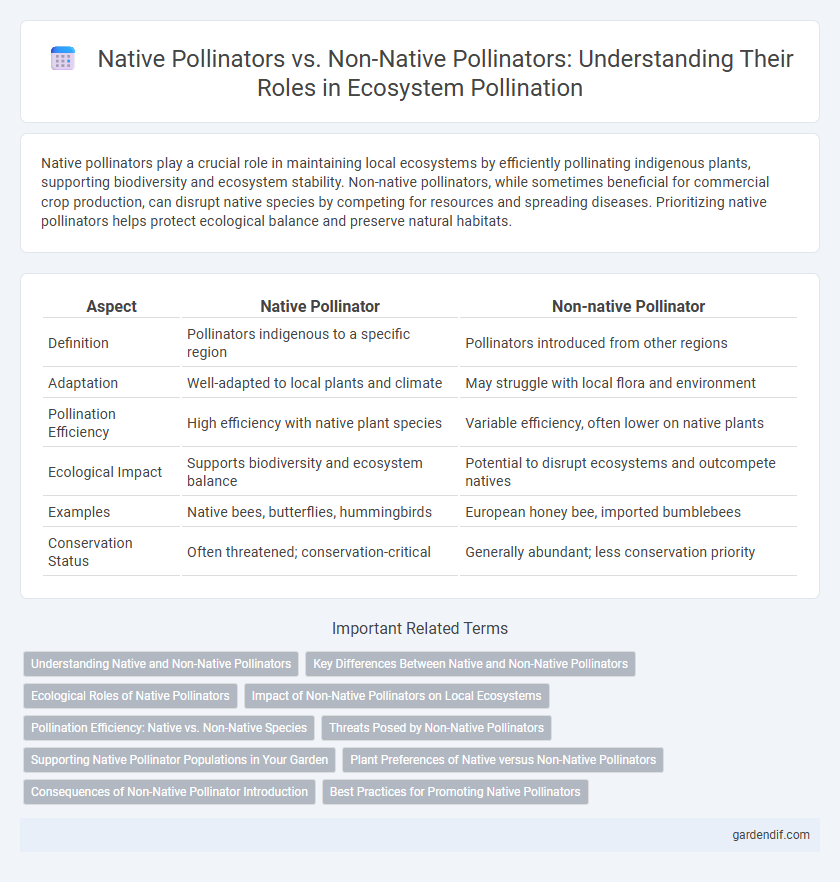
Native Pollinator vs Non-native Pollinator Illustration
Native pollinators play a crucial role in maintaining local ecosystems by efficiently pollinating indigenous plants, supporting biodiversity and ecosystem stability. Non-native pollinators, while sometimes beneficial for commercial crop production, can disrupt native species by competing for resources and spreading diseases. Prioritizing native pollinators helps protect ecological balance and preserve natural habitats.
Table of Comparison
| Aspect | Native Pollinator | Non-native Pollinator |
|---|---|---|
| Definition | Pollinators indigenous to a specific region | Pollinators introduced from other regions |
| Adaptation | Well-adapted to local plants and climate | May struggle with local flora and environment |
| Pollination Efficiency | High efficiency with native plant species | Variable efficiency, often lower on native plants |
| Ecological Impact | Supports biodiversity and ecosystem balance | Potential to disrupt ecosystems and outcompete natives |
| Examples | Native bees, butterflies, hummingbirds | European honey bee, imported bumblebees |
| Conservation Status | Often threatened; conservation-critical | Generally abundant; less conservation priority |
Understanding Native and Non-Native Pollinators
Native pollinators, such as native bees, butterflies, and hummingbirds, have co-evolved with local plants, creating essential mutualistic relationships that support ecosystem stability and biodiversity. Non-native pollinators, like the European honeybee, often lack these specialized interactions and can sometimes outcompete native species, disrupting local pollination networks. Understanding the ecological roles and impacts of both native and non-native pollinators is crucial for effective conservation and habitat restoration strategies.
Key Differences Between Native and Non-Native Pollinators
Native pollinators, such as bumblebees and solitary bees, have co-evolved with local plants, resulting in specialized relationships that enhance pollination efficiency and ecosystem stability. Non-native pollinators, including the introduced European honeybee, can compete with natives for floral resources, sometimes leading to reduced biodiversity and disrupted pollination networks. Understanding these key differences is crucial for conservation strategies that prioritize native species to maintain healthy habitats and sustainable plant reproduction.
Ecological Roles of Native Pollinators
Native pollinators, such as indigenous bees, butterflies, and birds, play a crucial role in maintaining local biodiversity by effectively pollinating native plants adapted to their unique ecosystems. Their co-evolution with native flora ensures higher pollination efficiency and plant reproductive success compared to non-native pollinators, which may not transfer pollen as precisely. Furthermore, native pollinators support ecosystem stability by promoting genetic diversity and sustaining food webs reliant on native plant species.
Impact of Non-Native Pollinators on Local Ecosystems
Non-native pollinators can disrupt local ecosystems by competing with native species for floral resources, often leading to declines in native pollinator populations. They may also introduce diseases and parasites unfamiliar to native pollinators, further jeopardizing vulnerable species. The altered pollination dynamics caused by non-native pollinators can negatively affect plant reproduction and biodiversity within native habitats.
Pollination Efficiency: Native vs. Non-Native Species
Native pollinators exhibit higher pollination efficiency due to their specialized adaptations to local flora, resulting in improved plant reproduction and biodiversity. Non-native pollinators, while capable of contributing to pollination, often lack the co-evolved relationships necessary for optimal pollen transfer and may even disrupt native ecosystems. Studies indicate that native species such as bumblebees and solitary bees enhance seed set and fruit quality more effectively than introduced species like honeybees in many habitats.
Threats Posed by Non-Native Pollinators
Non-native pollinators often disrupt local ecosystems by competing with native species for resources such as nectar and nesting sites, leading to declines in native pollinator populations. They can introduce diseases and parasites that native pollinators lack resistance to, exacerbating population stresses. The ecological imbalance caused by invasive pollinators results in reduced pollination efficiency for native plants, negatively impacting biodiversity and agricultural productivity.
Supporting Native Pollinator Populations in Your Garden
Supporting native pollinator populations in your garden enhances local biodiversity and improves the health of native ecosystems. Planting region-specific native flora provides essential nectar and pollen resources, fostering habitats suitable for native bees, butterflies, and hummingbirds. Avoid introducing non-native pollinators which can compete with natives for resources and potentially spread diseases.
Plant Preferences of Native versus Non-Native Pollinators
Native pollinators exhibit strong preferences for indigenous plant species, often forming specialized relationships that enhance pollination efficiency and plant reproduction. Non-native pollinators tend to be generalists, visiting a broader range of plants but sometimes favoring non-native or ornamental species, which can disrupt local plant-pollinator networks. Understanding these distinct plant preferences is crucial for biodiversity conservation and habitat restoration efforts aimed at supporting native pollinator populations.
Consequences of Non-Native Pollinator Introduction
Non-native pollinator introduction disrupts local ecosystems by outcompeting native pollinators for resources, leading to declines in native pollinator populations. These invasive species may also facilitate the spread of diseases and parasites, further threatening biodiversity. Altered pollination networks can negatively impact native plant reproduction, reducing ecosystem resilience and stability.
Best Practices for Promoting Native Pollinators
Promoting native pollinators involves planting diverse, region-specific flowering plants that provide continuous bloom throughout the growing season to meet their habitat and nutritional needs. Minimizing pesticide use and maintaining natural habitats with native vegetation supports the lifecycle and health of native pollinator populations. Creating pollinator-friendly environments by conserving nesting sites and reducing invasive species enhances native pollination efficiency and biodiversity.
Native Pollinator vs Non-native Pollinator Infographic

 gardendif.com
gardendif.com